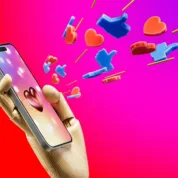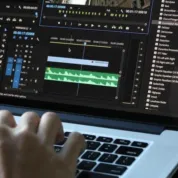
If you follow Band Pioneer, we know you love music. But do you also love to read? As a child would you pick up a book and imagine your own world where you could fantasize anything? Now take a second and imagine your website opening like a magical story, unfolding your music, products or services, the same way your favorite childhood story did.
In this article, we are going to discuss why storytelling continues to be an important component of an effective web design. We will also present a few examples, and ideas for how you can incorporate storytelling into your website.
Why Is Storytelling Important?
Storytelling seems to be everywhere, from the New York Times to your Instagram feed. The reason is simple. A story is the primary way we manage, absorb, retain, access, and communicate information. It is how our brains make sense of seemingly chaotic thoughts and ideas.
Great stories help us connect with others in a unique way. The latest research on storytelling reveals that when we listen to a story, our brain waves start to synchronize with those of the storyteller. The same happens when we read a narrative. It begins activating the areas of our brain that decipher an individual’s perspective and motives.
Naturally, our brain responds to a website better when it uses a story to explain its motive. Such a website helps us create mental models, cognitive maps, and narratives.
Let’s dig into more benefits of storytelling, in terms of web design and development.
Benefits of Storytelling
Stories persuade where facts cannot. Don’t believe us? That’s what science tells us. A website that leverages storytelling helps a visitor break through the haze of information overload and navigate better. Most importantly, stories help a brand or business connect with its audience. Here is how:
- Stories simplify complex ideas and concepts
- Storytelling can make ideas more memorable
- Powerful stories illicit emotions and feelings
In The Psychological Power of Storytelling, renowned author Pamela Brown Rutledge, suggests that ‘when brands, organizations, or individuals develop or identify a core story, they display and create authentic purpose that others can engage with and easily share.
That shows how invaluable storytelling is when creating a website or any other digital property.

Now that we know how storytelling can add more appeal to a website, let’s find out about the different types of storytelling for designing your web front.
Types of Digital Storytelling
Content Storytelling
The use of articles, marketing material, or on-site web copy across pages comes under content storytelling. A powerful web design relies on focused and targeted web copy which is why this type of storytelling can do wonders for your website.
On-site text is a crucial medium through which designers communicate with audience.
Most web designers undermine the power of text when creating a web design. However, text is an influential medium through which designers can communicate the history, values, and vision of a company.
Typically, online users search a website that can provide the best solution to their problems. Through text or content, a brand can establish its authority to gain the trust of their target audience. Popular forms of content such as case studies, white papers, and blogs can confirm visitors that they have reached a genuine and authoritative website.
Notice how Warby Parker narrates its story in the form of a case study. With nothing but optimized and targeted content, you get a powerful story that establishes the authority and credibility of the brand.
Visual Storytelling
This type of storytelling involves the strategic use of visual elements for reinforcing your branding and creating a narrative for readers to follow. If you ask any seasoned web designer, visual design is among the most important things viewers observe about a website.
Web designers focus on creating attractive color palettes and images that go in accordance with the theme of the brand. Such visual elements set a tone for the website. Generally, these components include:
- Illustrations
- Images
- Infographics
- Background Colors
These visual components are sure to elicit a different response from visitors and establish a concrete storytelling framework. Most company websites use a muted color palette with simple illustrations for inviting visitors so they can explore products and services easily. While others use abstract images for guiding visitors to their portfolio or contact us pages.
Check out the website of Nasa FDL Google Cloud. This HTML5 3D storytelling website template, from Google Cloud and NASA’s Frontier Development, impresses with a highly creative website.

The purpose of the website is to give information about space knowledge and research on finding life on other planets. The website incorporates advanced 3D technologies to create a beautiful effect of the outer space and planets through spellbinding effects. As users scroll through the website, they discover a great deal about space research and findings.
Video Storytelling
This type of storytelling involves using high-impact and engaging video content for connecting with your market. Video storytelling is a fabulous way to share your brand’s story and an easy way to capture attention. When a brand or business feels that they can’t convince their users through static imagery or text alone, videos come to the rescue.
It’s true that video content needs more time, effort, and investment than other forms of content. But, the results are worth it. If the goal of your website is to break down complex ideas and retain visitors for longer periods of time, invest in video storytelling.
For example, Nike’s Until We All Win campaign, encompasses a collection of short videos from Nike customers. We watch in amazement how these happy customers revisit their personal and athletic journey, their trials, and contributions as team members. Each of these stories is a proof of Nike’s commitment to social change by providing high-quality products to communities and aspiring individuals.
A new or small business may not have the marketing budget to create meaningful video testimonials from their customers. However, a simple 15-second video that shows your most loyal customers thanking your services can make a huge difference. Low-cost videos can boost other design elements of your website for delivering a valuable and memorable message.
Design Storytelling
The use of website design elements such as its layout, triggers, and animations can capture a visitor’s attention. Design storytelling communicates all little details about your brand to the audience. Since design is rooted in the concept of ‘show, don’t tell’, design-based storytelling brings together strategic site elements to engage and invite users.
Most of us don’t realize that the most crucial tool we have is the layout of the website. Let’s take the example of FullStory, a customer experience data platform provider. This website has a simple design and offers information that slowly unfolds with well-spaced text blocks and compelling imagery. As the visitor scrolls downs, he gets to know everything about the services of the company. Interactive elements such as demo requests prompt visitors to act and initiate engagement.
However, the most important part of the home page is at the end where the company invites you to become a part of their story. At the end of the page, there is an option to request a demo by providing few personal details. This completes the story which the company must tell for converting visitors into clients.
Digital Storytelling Techniques
Using Storytelling to Increase Webpage Engagement
We live in the era of bite-size media and low attention spans. Naturally, engaging readers is now more challenging than ever.
When you weave a persuasive narrative into the various design elements that go into the creation of a webpage, the result is a coherent experience for visitors. That’s why storytelling is a great way to design your home page, landing page, or about us page to share important information about your business.
Here are some basic elements that you should incorporate in your website design for effective storytelling.
Videos
Elite Content Marketer reveals that 66% of people prefer to watch a short video about a service or a product than read text of the same.

Now the question arises. Which video format should you choose: live actors, animated, or special effects?
A company’s overall marketing budget and its target audience will help in the decision-making process. Since a live action video takes more resources and time, many websites prefer creating animated videos.
A business can tell its whole story in one- or two-minute videos. However, the same message can be delivered in nearly thirty seconds. Whether a company decides to explain its services and products through animated videos or behind-the-scenes videos; videos are a powerful opportunity to connect with the audience.
Images
Research reveals that the human brain processes visual data more quickly than plain text. That means your web design story is incomplete without images. The right pictures set the right mood and a suitable tone for your website. Typically, these visuals feature the characters of the story for adding more depth to the narrative.
That way, a website compels the visitor to connects with the storyline, as you provide tons of information without burdening the reader. Just remember to keep the color scheme of the images, according to the theme of your branding or website.
Content
A story needs to have some text that supports visuals and images. But remember, the tone of this text is not the same as your promotional content like landing pages. Website content must have an intro, a middle part, and an ending. Don’t forget to add a CTA or contact information at the end of your website pages.
There is another thing that makes content memorable: the use of catchy phrases and headings. Imagine an average person who is browsing the internet, checking out dozens of websites. He lands on your site but finds nothing unique or original. There are little chances of him staying on your website for long.
On the other hand, catchy and creative stories are sure to retain his attention. That’s why your stories should be less fictional and more credible so audiences can believe in your brand stories.
Parallax Scrolling
Parallax scrolling is one the most visually appealing methods to engage a user’s attention and showcase all types of content. Parallax scrolling is not a new concept but is slowly regaining its popularity.
Many of today’s latest brands are using this technique for creating breathtaking visual stories. You can identify such websites by their background which moves at a slower rate than the foreground, as you scroll. The outcome is a 3D-like effect.
Seasoned web designers warn against overdoing this technique because its purpose should be to grab the attention of the user and not confuse him. Many websites use it sparingly while others use it for creating a big visual impact.
For example, the New York Times made great use of this technique in the Tomato Can Blues article. The webpage combines brilliant web design techniques with comic-inspired illustrations.
The article narrates the story of a cage fighter. The narrations come to life as you scroll through while clever alterations and animations immerse the reader in the story. These illustrations highlight witness accounts, police records, the reporter’s own notes, and photographs.
Infographics
Sometimes, emerging businesses don’t have the budget to make videos or incorporate parallax scrolling into its website. That’s when infographics come to help you craft a beautiful story. Narrating your brand story or customer journeys through appealing infographics is a proven way to retain and convert visitors. For example, the Lost World’s Fairs website features a stunning infographic about Atlantis and delivers data in an interactive manner. Another example is Every Last Drop with smooth animations and a funny drawing style.
Digital Storytelling Examples
Beautiful Examples of Websites that Incorporate Storytelling
If you want more inspiration, here are some beautiful websites that incorporate storytelling. You will fall in love with the fusion of colors, patterns, animations, images, content, and illustrations featured on the websites.
You Waste a Lot of Time at Work
Did you notice how these websites present a mix of different design elements to draw people into their story? That’s how you weave storytelling into a website.
Final Thoughts
Storytelling is an art, but it begins with research. To incorporate storytelling into your website, get to know your target audience for designing the right story. It’s important to become familiar with your audience’s purchasing patterns and their behavior when you are creating storytelling web designs for connecting with users.






Leave a Reply!
How can I proceed on self website creating
Click the contact link in the footer of this page and send us a message. We'll help you get it done!
I love the correlation drawn between childhood reading experiences and how a well-designed, story-driven website can elicit similar emotions and engagement. It's a fresh perspective that reinforces the critical role narratives play not only in literature but also in effective digital communication!
Thanks you so much for the kind words!